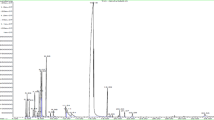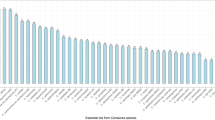Abstract
Many Eryngium species have been traditionally used as ornamental, edible or medicinal plants. The gas chromatography-flame ionization detector (GC-FID) and gas chromatography-mass spectrometry (GC–MS) analyses have shown that the major compounds in the aerial parts were spathulenol (in E. campestre and E. palmatum oils) and germacrene D (in E. amethystinum oil). The main compounds in the root oil were nonanoic acid, 2,3,4-trimethylbenzaldehyde and octanoic acid for E. campestre, E. amethystinum and E. palmatum, respectively. All the oils expressed the highest potential against Gram-positive bacteria Staphylococcus aureus as well as Gram-negative Klebsiella pneumoniae and Proteus mirabilis. Molecular docking analysis was used for determining a potential antibacterial activity mechanism of compounds present in the essential oils. Molecular docking confirmed that the binding affinity of spathulenol to the active site of tyrosyl-tRNA synthetase was the highest among the tested dominant compounds. Regarding the total phenolic content (determined by the Folin–Ciocalteu assay) and flavonoid content (evaluated using aluminum nitrate nonahydrate), the highest amount was found in the ethyl acetate extract of E. palmatum. The results of DPPH and ABTS assay indicated that the highest antioxidant activity was present in the water extract of E. amethystinum. Extracts of the aerial parts presented as minimum inhibitory concentration (MIC) expressed the activity in the range 0.004–20.00 mg/mL, with the highest activity exhibited by the acetone and ethyl acetate extracts against Proteus mirabilis. The obtained results suggest that Eryngium species may be considered a beneficial native source of the compounds with antioxidant and antimicrobial properties.


Similar content being viewed by others
References
Adams RP (2007) Identification of essential oil components by gas chromatography/mass spectrometry, 4th edn. Allured Publ. Corp, Carol Stream
Blois MS (1958) Antioxidant determinations by the use of a stable free radical. Nature 181:1199–1200
Bougatsos C, Ngassapa O, Runyoro DKB, Chinou IB (2004) Chemical composition and in vitro antimicrobial activity of the essential oils of two Helichrysum species from Tanzania. Z Naturforsch 59c:368–372
Capetanos C, Saroglou V, Marin PD, Simić A, Skaltsa HD (2007) Essential oil analysis of two endemic Eryngium species from Serbia. J Serb Chem Soc 72(10):961–965
Çelik A, Aydınlık N, Arslan I (2011) Phytochemical constituents and inhibitory activity towards methicillin-resistant Staphylococcus aureus strains of Eryngium species (Apiaceae). Chem Biodivers 8(3):454–459
Chater AO (1968) Genus Eryngium L. In: Tutin TG, Heywood VH, Burges NA, Moore DM, Valentine DH, Walters SM, Webb DA (eds) Flora Europaea 2. Cambridge University Press, London, pp 320–324
Conea S, Pârvu AE, Taulescu MA, Vlase L (2015) Effects of Eryngium planum and Eryngium campestre extracts on ligature-induced rat periodontitis. Dig J Nanomater Biostruct 10(2):693–704
Conea S, Vlase L, Chirilă I (2016) Comparative study on the polyphenols and pectin of three Eryngium species and their antimicrobial activity. Cellul Chem Technol 50(3–4):473–481
Cushnie TP, Lamb AJ (2005) Antimicrobial activity of flavonoids. Int J Antimicrob Agents 26:343–356
Džamić AM, Soković MD, Novaković M, Jadranin M, Ristić MS, Tešević V, Marin PD (2013) Composition, antifungal and antioxidant properties of Hyssopus officinalis L. subsp. pilifer (Pant.) Murb. essential oil and deodorized extracts. Ind Crop Prod 51:401–407
Flamini G, Tebano M, Cioni PL (2008) Composition of the essential oils from leafy parts of the shoots, flowers and fruits of Eryngium amethystinum from Amiata Mount (Tuscany, Italy). Food Chem 107:671–674
Güneş MG, İşgör BS, İşgör YG, Moghaddam NS, Geven F, Yildirim Ö (2014) The effects of Eryngium campestre extracts on glutathione-s-transferase, glutathione peroxidase and catalase enzyme activities. Turk J Pharm Sci 11(3):339–346
Kroemer RT (2007) Structure-based drug design: docking and scoring. Curr Protein Pept Sci 8(4):312–328
Küpeli E, Kartal M, Aslan S, Yesilada E (2006) Comparative evaluation of the anti-inflammatory and antinociceptive activity of Turkish Eryngium species. J Ethnopharmacol 107:32–37
Lapointe J (2013) Mechanism and evolution of multidomain aminoacyl-tRNA synthetases revealed by their inhibition by analogues of a reaction intermediate, and by properties of truncated forms. J Biomed Sci Eng 6:943–946
Li YY, An J, Jones SJM (2011) A computational approach to finding novel targets for existing drugs. PLoS Comput Biol 7(9):e1002139
Marčetić MD, Petrović SD, Milenković MT, Niketić MS (2014) Composition, antimicrobial and antioxidant activity of the extracts of Eryngium palmatum Pančić and Vis. (Apiaceae). Cent Eur J Biol 9(2):149–155
Matejic JS, Dzamic AM, Mihajilov-Krstev T, Ristic MS, Randelovic VN, Krivošej ZĐ, Marin PD (2016) Chemical composition, antioxidant and antimicrobial properties of essential oil and extracts from Heracleum sphondylium L. J Essent Oil Bear Pl 19(4):944–953
Miller N, Rice-Evans C (1997) Factors influencing the antioxidant activity determined by the ABTS radical cation assay. Free Radic Res 26:195–199
NCCLS-National Committee for Clinical Laboratory Standards (2003) Performance standards for antimicrobial susceptibility testing. Eleventh informational supplement M100-S11. CLSI, Wayne, PA
Nebija F, Gj Stefkov, Karapandzova M, Stafilov T, Panovska TK, Kulevanova S (2009) Chemical characterization and antioxidant activity of Eryngium campestre L., Apiaceae from Kosovo. Maced Pharm Bull 55(12):22–32
Ouerghemmi S, Sebei H, Siracusa L, Ruberto G, Saija A, Cimino F, Cristani M (2016) Comparative study of phenolic composition and antioxidant activityof leaf extracts from three wild Rosa species grown in different Tunisiaregions: Rosa canina L., Rosa moschata Herrm. and Rosa sempervirens L. Ind Crop Prod 94:167–177
Pichette A, Pierre-Luc Larouche PL, Lebrun M, Legault J (2006) Composition and antibacterial activity of Abies balsamea essential oil. Phytother Res 20:371–373
Ramya LN, Pulicherla KK (2015) Molecular insights into cold active polygalacturonase enzyme for its potential application in food processing. J Food Sci Technol 52(9):5484–5496
Sahin F, Gulluc M, Daferera D, Sokmen A, Sokmen M, Polissiou M, Agar G, Ozer H (2004) Biological activities of the essential oils and methanol extract of Origanum vulgare ssp. vulgare in the eastern Anatolia region of Turkey. Food Control 15:549–557
Singh JP, Kaur A, Shevkani K, Singh N (2016) Composition, bioactive compounds and antioxidant activity of common Indian fruits and vegetables. J Food Sci Technol 53(11):4056–4066
Singleton VL, Orthofer R, Lamuela-Raventos RM (1999) Analysis of total phenols and other oxidation substrates and antioxidants by means of Folin–Ciocalteu reagent. Methods Enzymol 299:152–178
Sivropoulou A, Nikobu C, Papanikolaou E, Kokkini S, Lanaras T, Arsenakis M (1997) Antimicrobial, cytotoxic, and antiviral activities of Salvia fruticosa essential oil. J Agric Food Chem 45:3197–3201
Sourmaghi MHS, Kiaee G, Golfakhrabadi F, Jamalifar H, Khanavi M (2015) Comparison of essential oil composition and antimicrobial activity of Coriandrum sativum L. extracted by hydrodistillation and microwave-assisted hydrodistillation. J Food Sci Technol 52(4):2452–2457
Thiem B, Kikowska M, Kurowska A, Kalemba D (2011) Essential oil composition of the different parts and in vitro shoot culture of Eryngium planum L. Molecules 16(8):7115–7124
Thomsen R, Christensen MH (2006) MolDock: a new technique for high-accuracy molecular docking. J Med Chem 49(11):3315–3321
Usta C, Yildirim AB, Turker AU (2014) Antibacterial and antitumour activities of some plants grown in Turkey. Biotechnol Biotechnol Equip 28(2):306–315
Wang P, Su Z, Yuan W, Deng G, Li S (2012) Phytochemical constituents and pharmacological activities of Eryngium L. (Apiaceae). Pharm Crops 3:99–120
Woisky R, Salatino A (1998) Analysis of propolis: some parameters and procedures for chemical quality control. J Apic Res 37:99–105
Wojtanowski KK, Skalicka-Woźniak K, Głowniak K, Mroczek T (2013) Screening of the antioxidant potentials of polar extracts from fruits of Eryngium planum and Eryngium amethystinum using the β-carotene-linoleic acid assay. Curr Issues Pharm Med Sci 26(3):276–278
Acknowledgements
The authors are grateful to the Ministry of Education, Science and Technological Development of the Republic of Serbia for financial support (Grant No. 173029).
Author information
Authors and Affiliations
Corresponding author
Additional information
The author Mihailo S. Ristić is deceased.
Rights and permissions
About this article
Cite this article
Matejić, J.S., Stojanović-Radić, Z.Z., Ristić, M.S. et al. Chemical characterization, in vitro biological activity of essential oils and extracts of three Eryngium L. species and molecular docking of selected major compounds. J Food Sci Technol 55, 2910–2925 (2018). https://doi.org/10.1007/s13197-018-3209-8
Revised:
Accepted:
Published:
Issue Date:
DOI: https://doi.org/10.1007/s13197-018-3209-8




